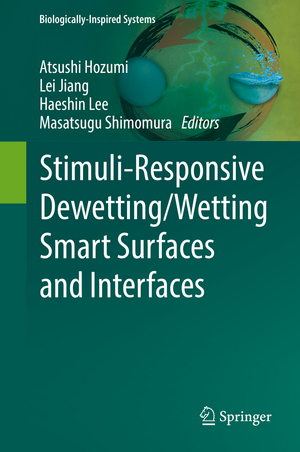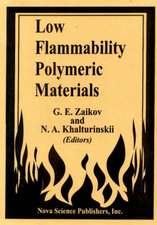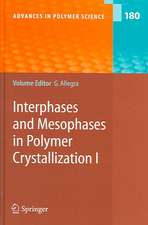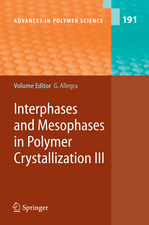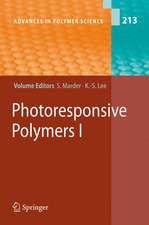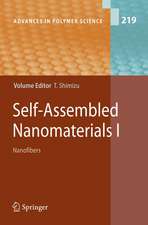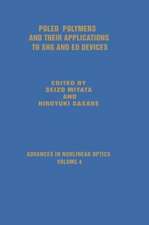Stimuli-Responsive Dewetting/Wetting Smart Surfaces and Interfaces: Biologically-Inspired Systems, cartea 11
Editat de Atsushi Hozumi, LEI JIANG, Haeshin Lee, Masatsugu Shimomuraen Limba Engleză Hardback – 27 noi 2018
Preț: 408.92 lei
Nou
Puncte Express: 613
Preț estimativ în valută:
78.25€ • 81.86$ • 65.00£
78.25€ • 81.86$ • 65.00£
Carte disponibilă
Livrare economică 12-26 martie
Preluare comenzi: 021 569.72.76
Specificații
ISBN-13: 9783319926537
ISBN-10: 3319926535
Pagini: 15
Ilustrații: XI, 464 p. 299 illus., 192 illus. in color.
Dimensiuni: 155 x 235 mm
Greutate: 0.91 kg
Ediția:1st ed. 2018
Editura: Springer International Publishing
Colecția Springer
Seria Biologically-Inspired Systems
Locul publicării:Cham, Switzerland
ISBN-10: 3319926535
Pagini: 15
Ilustrații: XI, 464 p. 299 illus., 192 illus. in color.
Dimensiuni: 155 x 235 mm
Greutate: 0.91 kg
Ediția:1st ed. 2018
Editura: Springer International Publishing
Colecția Springer
Seria Biologically-Inspired Systems
Locul publicării:Cham, Switzerland
Cuprins
Chapter1. Introduction of Stimuli-Responsive Wetting/Dewetting Smart Surfaces and Interfaces.- Part 1. Stimuli-Responsive Dewetting/Wetting Surfaces/Interfaces. Chapter 2. Photo-Responsive Superwetting Surface.- Chapter 3. pH Responsive Reversibly Tunable Wetting Surfaces.- Chapter 4. Thermal-Responsive Superwetting Surface.- Chapter 5. Electric-Responsive Superwetting Surface.- Chapter6. Liquids on Shape-Tunable Wrinkles.- Chapter7. Solvent Response.- chapter8. Magnetic-Responsive Superwetting Surface.- Part 2. Practical Applications. chapter 9. Stimuli-Responsive Smart Surfaces for Oil/Water Separation Applications.- Chapter 10. Anti-(bio)Fouling.- Chapter 11. Toward Eadaptive Anti-icing Coating.- Chapter 12. Stimulus-Responsive Soft Surface/Interface Toward Applications in Adhesion, Sensor and Biomaterial.- Chapter 13. Liquid manipulation.- Chapter14. Material-Independent Surface Modification Inspired by Principle of Mussel Adhesion.- Chapter 15. Stimuli-Responsive Mussel-inspired Polydopamine Material.
Notă biografică
Atsushi Hozumi is a group leader of Advanced Surface and Interface Chemistry Group, Structural Materials Research Institute, The National Institute of Advanced Industrial Science and Technology (AIST), Nagoya, Japan. He received a PhD in Material Processing Engineering at Nagoya University, Japan, in 1997. He then joined National Industrial Research Institute of Nagoya (NIRIN), Ministry of Trade and Industry, Japan in 1999 (reorganized as AIST in 2001). He also spent 2007 as a visiting scholar at University of Bristol, England (Prof. Stephen Mann’s group) and as a visiting professor of University of Massachusetts Amherst, USA (Prof. Thomas J. McCarthy’s group). His research interests are wettability/dewettability, biomimetic materials, micro/nanofabrication and self-assembled monolayers, and their practical applications. He currently serves on the editorial boards of the Materials Letters, Elsevier.
Lei Jiang received his B.S. degree in solid state physics (1987), and M.S. degree in physical chemistry (1990) from Jilin University in China. From 1992 to 1994, he studied in the University of Tokyo in Japan as a China-Japan joint course Ph.D. student and received his Ph.D. degree from Jilin University of China with Prof. Tiejin Li. Then, he worked as a postdoctoral fellow in Prof. Akira Fujishima’s group in the University of Tokyo. In 1996, he worked as researcher in Kanagawa Academy of Sciences and Technology, Prof. Hashimoto’s project. In 1999, he joined Institute of Chemistry, Chinese Academy of Sciences (CAS). In 2015, he moved to the Technical Institute of Physics and Chemistry, CAS. Since 2008, he also served as the dean of School of Chemistry and Environment in Beihang University. He was elected as members of the Chinese Academy of Sciences and The World Academy of Sciences in 2009 and 2012. In 2016, he also elected as a foreign member of the US National Academyof Engineering. He has been recognized for his accomplishments with Humboldt Research Award (Germany, 2017), Nikkei Asia Prize (Japan, 2016), MRS Mid-Career Researcher Award (USA, 2014), National Natural Science Award (China, 2005), and many other honors and awards. He has published over 500 papers including 3 papers in Nature, 1 paper in Science, 1 paper in Nature Nanotechnology, 1paper in Nature Reviews Materials, 1 paper in Nature Materials, 6 papers in Natural Communication, 5 papers in Science Advance, 3 papers in Chem. Rev., 7 papers in Chem. Soc. Rev., 6 papers in Acc. Chem. Res., 46 papers in Angew. Chem. Int. Ed., 31 papers in J. Am. Chem. Soc., and 128 papers in Adv. Mater., the works have been cited more than 56000 times with an H index of 117.
Professor Haeshin Lee studied at KAIST where he received his B.S. degree in Biological Sciences between in 1996. He received his Ph.D. degree at Biomedical Engineering Department, Northwestern University in 2007. He startedhis professional carrier from 2009 at Department of Chemistry, KAIST. He is a currently director of Center for Nature-inspired Technology (CNiT) at KAIST. Haeshin Lee invented the first material-independent surface chemistry named ‘polydopamine’ in 2007, and this study has been one of the most cited paper in surface chemistry. He is the founding member of Korea Academy of Science Young Scholars and is an Associate Editor in Biomaterials Science (RSC).Lei Jiang received his B.S. degree in solid state physics (1987), and M.S. degree in physical chemistry (1990) from Jilin University in China. From 1992 to 1994, he studied in the University of Tokyo in Japan as a China-Japan joint course Ph.D. student and received his Ph.D. degree from Jilin University of China with Prof. Tiejin Li. Then, he worked as a postdoctoral fellow in Prof. Akira Fujishima’s group in the University of Tokyo. In 1996, he worked as researcher in Kanagawa Academy of Sciences and Technology, Prof. Hashimoto’s project. In 1999, he joined Institute of Chemistry, Chinese Academy of Sciences (CAS). In 2015, he moved to the Technical Institute of Physics and Chemistry, CAS. Since 2008, he also served as the dean of School of Chemistry and Environment in Beihang University. He was elected as members of the Chinese Academy of Sciences and The World Academy of Sciences in 2009 and 2012. In 2016, he also elected as a foreign member of the US National Academyof Engineering. He has been recognized for his accomplishments with Humboldt Research Award (Germany, 2017), Nikkei Asia Prize (Japan, 2016), MRS Mid-Career Researcher Award (USA, 2014), National Natural Science Award (China, 2005), and many other honors and awards. He has published over 500 papers including 3 papers in Nature, 1 paper in Science, 1 paper in Nature Nanotechnology, 1paper in Nature Reviews Materials, 1 paper in Nature Materials, 6 papers in Natural Communication, 5 papers in Science Advance, 3 papers in Chem. Rev., 7 papers in Chem. Soc. Rev., 6 papers in Acc. Chem. Res., 46 papers in Angew. Chem. Int. Ed., 31 papers in J. Am. Chem. Soc., and 128 papers in Adv. Mater., the works have been cited more than 56000 times with an H index of 117.
After graduating from Kyushu University in 1980, Masatsugu Shimomura engaged in the field of biomimetic chemistry as an assistant professor of Prof. Toyoki Kunitake’s laboratory. He developed the research of polymeric Langmuir-Blodgett films at Tokyo University of Agriculture and Technology as an associate professor from 1985, and moved to Hokkaido University at 1993 for starting a new laboratory of the bottom-up nanotechnology based on self-organization and biomimetics. Self-organized honeycomb-patterned polymer films arenewly developed by collaboration with many industrial companies and the RIKEN institute where he held concurrently post of the principle investigator from 1999 to 2007. After moving to Tohoku University at 2007 he organized a national research project on Engineering Neo-Biomimetics, and started an educational program on biomimetics at Chitose Institute of Science and Technology from 2014. He worked with Prof. Helmut Ringsdorf of Mainz University in 1982 and Prof. Erich Sackmann of TU-Munich in 1987, respectively. He is a Professor emeritus of Hokkaido University and Tohoku University.
Caracteristici
Summarizes the latest studies on stimuli-responsive dewetting/wetting smart surfaces and interfaces Reviews the key recent research on stimuli-responsive dewetting/wetting smart surfaces and interfaces Explains how to design and establish these Superhydrophobic artificial surfaces
